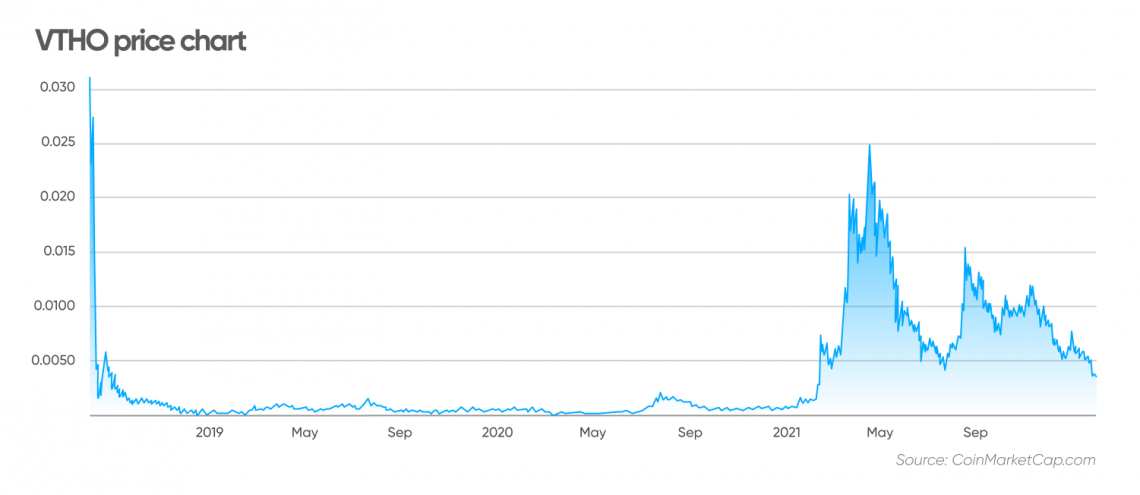Vethor (VTHO) price prediction: Will the coin rise or fall?

The vethor (VTHO) price has fallen in the past three weeks, dropping to its lowest level in close to a year. What is the vethor token and how does it work?
The VeChainThor blockchain runs a dual-token structure, with VTHO used to facilitate smart contract transactions on the network while VET is used to transfer value. VeChain recently completed the first phase of a network upgrade, with phases 2 and 3 to follow.
In this VTHO price analysis, we look at the recent developments in the protocol and expectations for the token in the future.
VeChainThor pushes enterprise blockchain adoption
Founded in 2015 by Sunny Lu as a subsidiary of Chinese blockchain company Bitse, VeChain later became independent and rebranded in 2018.
The VeChainThor blockchain is designed to encourage enterprises of various sizes to adopt sustainable and scalable blockchain technology, supported by its governance and protocol enhancements.
VeChainThor aims to address some of the challenges in using the Ethereum blockchain to host enterprise-scale commercial decentralised applications (dApps). VeChain says in its documentation:
VeChain claims that features like multi-party payments, multi-task transactions, a controllable transaction lifecycle and transaction dependency make it more user-friendly for enterprise adoption.
VeChain has created its two-token cryptocurrency system in an attempt to create more certainty for enterprise users, separating the cost of using the blockchain from market speculation, which drives price volatility.
“Due to the correlation with the blockchain resource utilisation, the cost is more predictable with the monitoring of the VTHO supply and demand. In addition, [the] foundation's governance mechanism further stabilises the cost,” according to the project’s website.
VTHO tokens are destroyed after on-chain operations are performed.

In November 2021, the VeChainThor mainnet, or live network, completed the first phase of its upgrade to a proof-of-authority (PoA) 2.0 consensus mechanism. The algorithm comprises three main elements:
Verifiable random function (VRF) for proof that blockchain calculations are correct
Committee-based process for creating blocks
Passive process for confirming block finality
VeChain said the upgrade was needed “to meet the demands of future blockchain applications and increasing global demand. Enterprises demand data security (finality) but also need high throughput and scalability.”
Apparel companies have been adopting VeChainThor for supply chain data and verification. On 22 November, custom footwear and high-tech streetwear marketplace Deadstock announced plans to use VeChain’s blockchain technology for authentication in the US and Canadian markets.
Meanwhile on 3 December, Canadian sustainable apparel firm Frank And Oak opened its first store in Asia, in Shanghai, showcasing a winter collection that uses yarns and processes traced by VeChainThor.
Governments are also using the platform. On 24 December, VeChain said it had built a government traceability platform for agricultural products in Inner Mongolia, China.
On 4 January, VeChain announced plans to launch its first stablecoin, VeUSD, enabling next-generation Internet (Web3), decentralised finance (DeFi), sustainability objectives and other applications. The developers are also working on plans to integrate a widget into the VeChainThor wallet during the first quarter, which would give users easy access to VeUSD minting and redemption.
The vethor coin price rose in response to the news on 4 January 2022 from $0.006175 to a high of $0.006517, moving up further to an intraday high of $0.006858 on 5 January. But the chart shows the price has since declined, falling to a low of $0.003269 on 24 January – its lowest level since mid-February 2021.
The VTHO price had rallied along with the wider cryptocurrency markets in the first few months of 2021, climbing from $0.0007072 at the start of January 2021 to a peak of $0.0281 on 17 April. That was its highest level since its launch at the end of July 2018, when it traded up to its all-time high of $0.061917 in just three days.

VTHO followed the cryptocurrency price trend lower with the May 2021 sell-off, then rallied over the summer to $0.01711 in mid-August. The price retreated during the September price decline before spiking again to $0.01289 in November.
What is the vethor token potential for the remainder of 2022 and in the coming years? Can the price rebound, or will it continue to trend lower?
Vethor token (VTHO) price prediction: Will it rebound or extend its decline?
VTHO technical analysis by CoinCodex was bearish at the time of writing on 27 January with the token trading around $0.0038. There were 17 indicators showing bearish signals compared with 14 bullish signals. Despite the bearish short-term sentiment, CoinCodex predicted the value of VTHO could rise to $0.0041 by 1 February.
Algorithm-based forecast site WalletInvestor was bullish in its long-term vethor token price prediction, estimating the price could rise to an average of $0.0100 by the end of 2022. The site predicted that VTHO could stabilise to end 2023 at $0.0169 and then edge up to $0.0237 by the end of 2024. According to its VTHO price prediction, the price could rise further to $0.0305 by the end of 2025 and $0.0375 in five years’ time.
The vethor token prediction from Gov Capital similarly suggested that the price could rise to $0.0106 by the end of 2022 and reach $0.0214 by the end of 2023. But based on deep-learning technical analysis, Gov Capital’s VTHO crypto price prediction expected the price rise to accelerate to $0.0517 by the end of 2025 and $0.0748 by January 2027.
DigitalCoin's VTHO prediction expected a slower growth trajectory, with its forecast based on historical data. It predicts the price could average $0.0053 in 2022 and $0.0087 by 2025, reaching $0.0161 in 2029.
Deep artificial intelligence-assisted technical analysis from PricePrediction was positive on the longer-term growth outlook with its VTHO coin price prediction. The site projected the price could average $0.006 in 2022, rising to an average of $0.018 in 2025 and hitting the $0.11 level in 2030.
It’s important to remember that cryptocurrency markets are extremely volatile, making it difficult to predict accurately what a coin’s price will be in a few hours and even harder to give long-term estimates. As such, analysts and algorithm-based forecasters can get their vethor token crypto price predictions wrong.
If you are considering investing in cryptocurrency tokens such as vethor, we recommend that you always do your own research. Look at the latest market trends, news, technical and fundamental analysis, and expert opinion before making any investment decision. Bear in mind that past performance is no guarantee of future returns.
FAQs
Will the vethor token go up or down?
At the time of writing, some vethor token coin price predictions expected the VTHO price to trend higher in coming years. But it is important to keep in mind that cryptocurrency prices are highly volatile and difficult to predict. Forecasters can and do get their predictions wrong. You should do your own research to make informed trading decisions. Bear in mind that past performance is no guarantee of future returns.
Is vethor (VTHO) a good investment?
In volatile cryptocurrency markets, it is important to do your own research on a coin or token to determine if it is a good fit for your investment portfolio. Whether the VTHO token is a suitable investment for you depends on your risk tolerance and how much you intend to invest. Never invest more than you can afford to lose.
Will vethor reach $0.01?
At the time of writing, some forecast sites, such as WalletInvestor and Gov Capital, expect the VTHO price to reach $0.01 by the end of 2022, while other sites such as DigitalCoin and PricePrediction predict it to take until 2025 to reach that level.
It is important to bear in mind that cryptocurrency prices are highly volatile and difficult to predict. Forecasters can and do get their predictions wrong. You should do your own research to make informed trading decisions. Remember that past performance is no guarantee of future returns.




